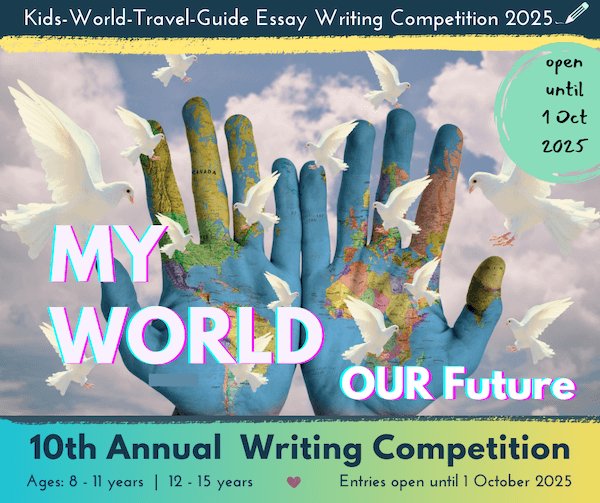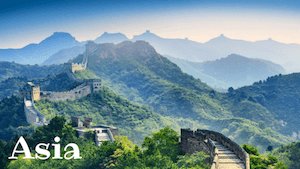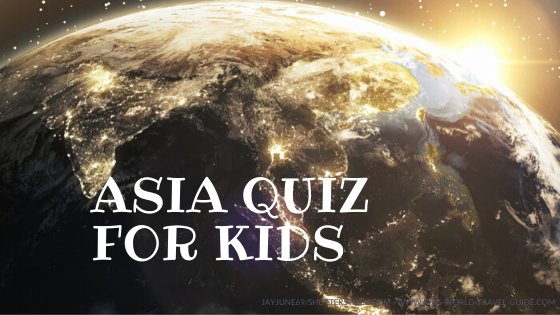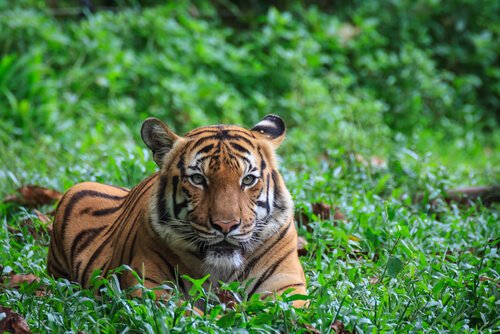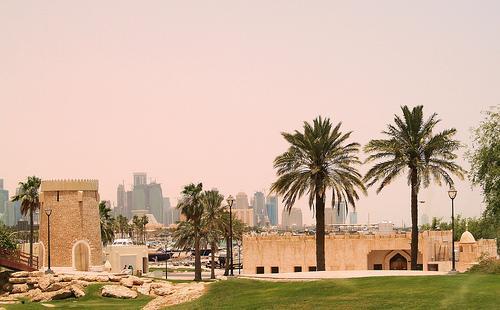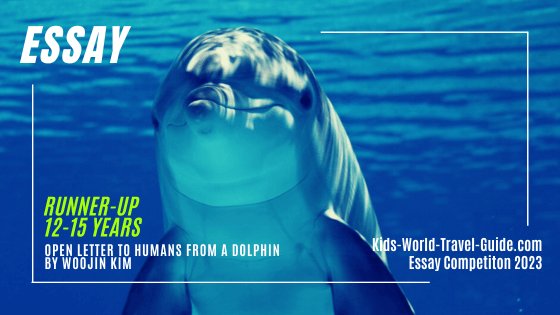- Homepage
- Senior Winner 2024
The Pearl of the Orient Seas
Essay Writing Competition 2024
Category: 12 - 15 years
- Winner -

"The Pearl of the Orient Seas" written by John Caleb Magnaye-Talusan was chosen as winner in the Senior category 12 -15 years.
This article was submitted in the Kids World Travel Guide Essay Competition 2024.

The Pearl of the Orient Sea
"Ang hindi marunong lumingon sa pinanggalingan ay hindi makakarating sa paroroonan."
(He who doesn’t know how to look back at where he came from will never get to his destination.) - Jose P. Rizal
Whenever I go to the palengke, or market, I walk on the same streets our national hero, Jose P. Rizal once walked on. Usually, I never give it some thought. One day, my mom took me to a museum just across the road from the palengke. It preserved the same bahay kubo (small bamboo hut) that housed Jose Rizal’s tutor in the late 19th century. Because of that trip, I now love trips to the market, because I am reminded of the historical significance of my town.
I am a Filipino citizen. I live in the Province of Laguna. My culture shapes part of my identity. What shapes my culture? 300 years of Spanish influence, half a century of exposure to American culture, and many bits and pieces of pre-Hispanic Philippines. My country, the Philippines, is a culturally diverse country.
There are a lot of different traditions and societies in Luzon, Visayas, and Mindanao. However there are basic similarities in most of them. One of these similarities is honoring elders. As a Filipino, I respect my parents, grandparents, and anyone older than me. Here’s an example. Whenever I enter the house of a friend, I always ask for mano, or blessing. I will ask for their hand, hold it and then gently put it on my head. It is a sign of respect. I do the same in my relatives’ house, especially with seniors.
Another uniting factor of Philippine culture is food. Yes, all cultures have food. No party or visitation is complete without anyone bringing food. Sometimes, it is simple delicacies like puto binan (rice cake), pichi-pichi (cassava cake), adobo, caldereta, and sinigang. Other times, something as lavish as lechon baboy (roasted pig), or leche flan (egg and milk pie that is steamed) is brought to a party. Filipinos love eating food. That is why it is at every social event. There is even an event called a boodle fight, where Filipinos eat with their hands food served on banana leaves (I saw one when I was 7.) There is also another event called a fiesta, when neighbors would visit each other and eat food, and then move on to the next house and eat there too, and so on.
And yet another uniting tradition is Bayanihan. Bayanihan describes the pride and belonging one has for his/her community and the willingness to help those in need. It could be simple acts like helping neighbors during a move. Or it could be even more serious like helping to put out a fire in a neighbor’s house, which happened in my community.
One unique Filipino tradition is the four months of Christmas. Yes, the season here lasts four months, or starts in September and ends in January. I would know when the season starts because traditional Filipino Christmas songs will be playing repeatedly on the radio, in the supermarket, and everywhere else. In fact, during those four months, there was a point when kids would go out into the streets, and sing Christmas carols, and I would give them a coin. Aside from traditional songs, I know it is Christmas when people put Christmas lights around their houses, and a parol, or a star-shaped Christmas ornamental lantern, to symbolize the star of Bethlehem. We celebrate the birth of Jesus Christ in that uniquely Filipino way, besides just celebrating it on Christmas day.
I have moved around the world for much of my young life. I have been to many places, and have made it halfway around the world. However, no matter where I am, I always keep coming back or looking back at the Philippines.
All of these traditions I have mentioned, they are a part of me. They shape who I am today, and make me unique as a citizen of the global community. So even now, as my family considers traveling to another country again, I always think about my nation, because it is part of my identity.
Who am I? I am a twelve-year old Filipino. I live in the Province of Laguna, Philippines. The Pearl of the Orient Seas.
In the Age category 12 - 15 years, John Caleb's exemplary essay was chosen as one of the two winning entries. Thank you so much for sharing your reflections on your culture with vivid descriptions of your country's traditions. It is with great pleasure seeing you cherish your writing talent and flying high again!
John Caleb won the Junior category last year. Without knowing the student's names and home countries, we all were stunned to find another fine piece of writing by you as our winning entry!) Congratulations!
John Caleb is homeschooled and lives in the Philippines. His home language is Filipino, English is his second language.
Popular Pages
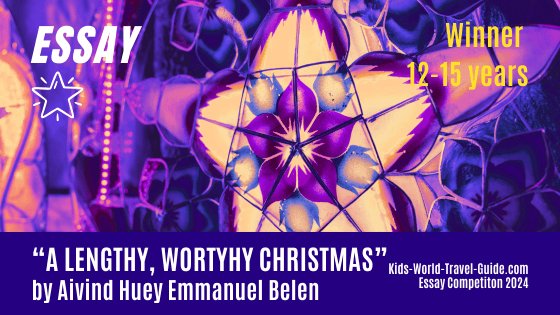 Essay Co-Winner 2024 Essay Co-Winner 2024 |
Competition Winners 2024
 |
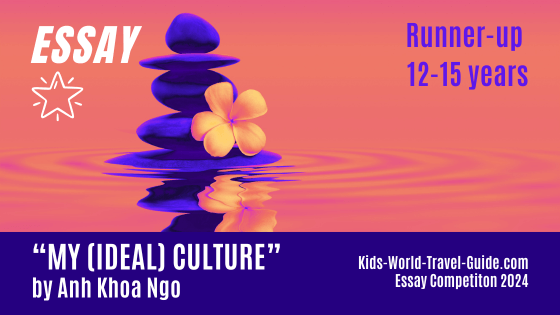 |
Popular Pages
Country Facts for Kids
Christmas Special Pages
Recent Articles
-
Facts about Bulgaria for Kids | Bulgaria Facts | Geography | Travel
Jun 15, 25 05:09 AM
Facts about Bulgaria for Kids with fun and important facts about country and people, geography superlatives, food, animals and landmarks and so much more -
India for Kids | India Facts for Kids | Geography | People | Animals
Jun 12, 25 11:15 AM
Our India for Kids page will tell you all about incredible India, the country and its people, landmarks, animals, food and so much more -
Croatia Facts for Kids | Facts about Croatia | Geography | Animals
Jun 12, 25 11:03 AM
The most important Croatia facts: Croatian people and culture, famous attractions, yummy Croatian food, wildlife, economy and so much more. -
Ecuador Facts for Kids | Ecuador for Kids | Geography | Travel | Food
May 30, 25 05:43 AM
Our Ecuador Facts provide insights and fun facts for kids with information on geography, attractions, people, animals, economy and food -
Iceland Facts for Kids | Geography | Attractions | Animals | Food
May 29, 25 05:55 AM
Our Iceland Facts for Kids will provide interesting fun facts about Iceland, the land of fire and ice, its volcanoes, glaciers and attractions -
Panama Facts for Kids | Facts about Panama | Geography | Travel | Food
May 28, 25 06:01 AM
Our Panama Facts for Kids provide useful and fun facts about Panama, the American country that is known for the artificial waterway and high biodiversity
Back from 'The Pearl of the Orient Seas' to Essay Competition Winners Listing 2024
Return to Kids-World-Travel-Guide Homepage
More about Countries and Territories in Asia
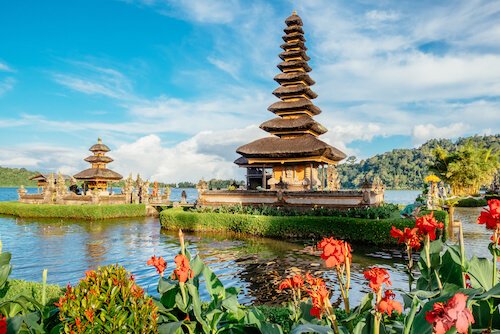 Indonesia
Indonesia Nepal
Nepal Sri Lanka
Sri Lanka Thailand
Thailand















